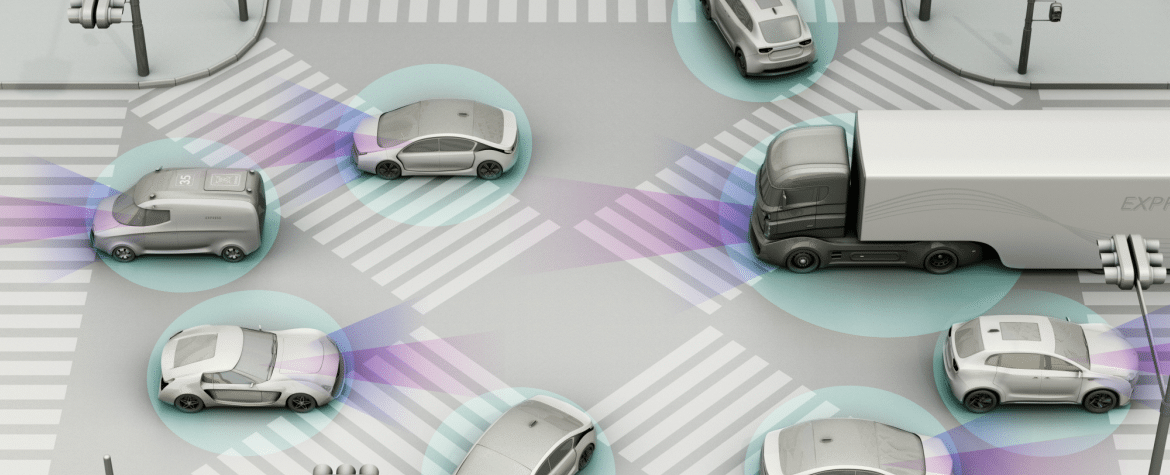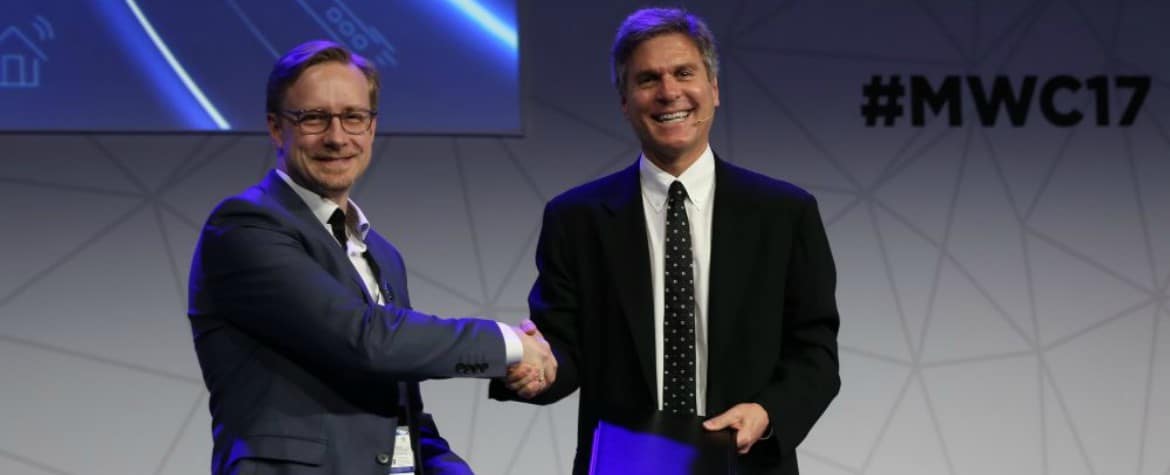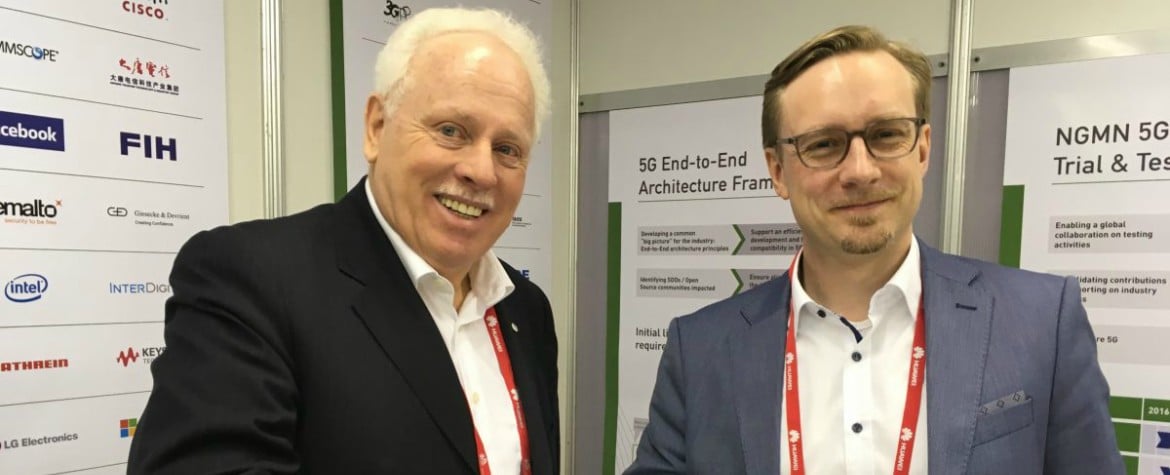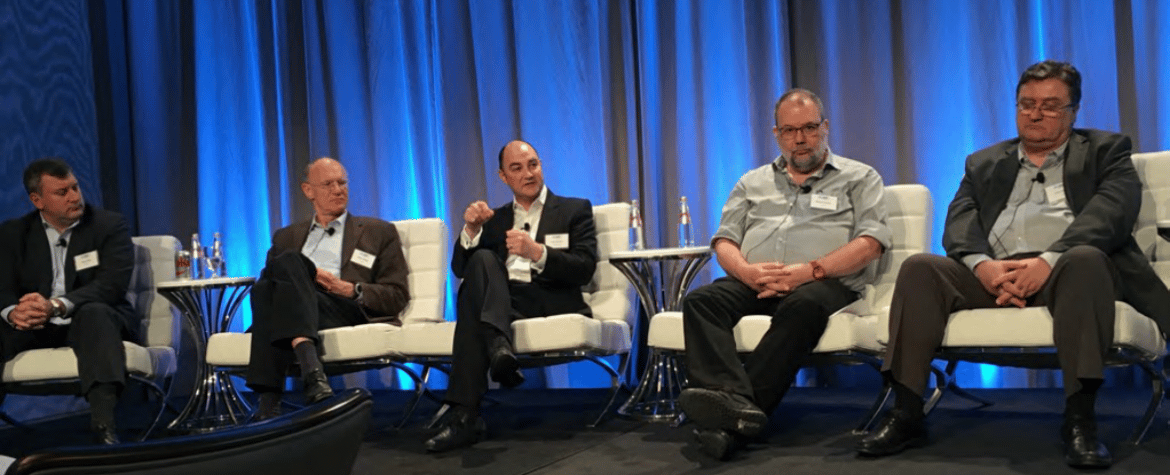
5GAA submitted comments to the National Highway Traffic Safety Administration
The 5G Automotive Association (5GAA) submitted comments to the National Highway Traffic Safety Administration (NHTSA) notice of proposed rulemaking (NPRM), “Federal Motor Vehicle Safety Standards; V2V Communications.” The proposed rule is to mandate new light-duty vehicles to be equipped with dedicated short range communications (DSRC).
The 5GAA is a new global cross-industry association of automotive, technology and telecommunications companies and includes 42 members, of which 8 are founding members (AUDI AG, BMW Group, Daimler AG, Ericsson, Huawei, Intel, Nokia, Qualcomm). Our mission is to enable communications solutions that address society’s connected mobility and road safety needs.
In our submission, 5GAA applauds the concept behind the rule, as V2V safety is important to our technology deployment mission. 5GAA urges NHTSA to not consider just the best technology of today, but also to consider the best technologies of tomorrow. Such an approach will promote innovation and competitive market-based outcomes, ensuring that American drivers and passengers benefit from the best and most advanced safety solutions available as technology evolves. Rigid technology mandates such as specifying DSRC, whether direct or de facto, freeze technology solutions to a past point in time. NS will significantly impede the innovation and evolution path for Vehicle-to-Vehicle (V2V) safety, and positions the US to lag behind the rest of the world in V2V communications specifically as well as V2X broadly. 5GAA elaborates on the following points:
Similar to DSRC, Cellular-V2X technology for V2V safety can transmit BSM in an ad hoc manner without cellular network coverage.
Cellular-V2X technology for V2V safety communications can operate without a SIM card and offers the tools to adopt, evolve or innovate any privacy-preserving security management system including SCRM.
Cellular-V2X technology for V2V safety benefits from a significantly larger link budget than DSRC (e.g., 8 dB at high speeds), corresponding to twice the range of DSRC and higher reliability.
Cellular-V2X technology for V2V safety can support up to 50 messages per second with less than 20 msec latency.
Cellular-V2X enables V2V, and for that matter Vehicle-to-Infrastructure (V2I), Vehicle-to-Pedestrian (V2P) and Vehicle-to-Network (V2N), safety applications to take advantage of the widespread cellular network coverage in the US.
5GAA notes also that the impending launch of 5G will only widen the performance gap between Cellular- V2X and DSRC.
5GAA believes that Rather than moving forward with the proposed regulation, NHTSA should instead undertake an updated, comprehensive technology neutral analysis of V2V solutions, including DSRC and Cellular-V2X, against the performance requirements in the NPRM. If this review indicates that regulatory action is necessary, the U.S. Department of Transportation should move forward with a technology neutral regulation that sets forth minimum V2V safety performance requirements only.

5GAA comments to the NHTSA on notice of proposed rulemaking
The 5G Automotive Association (5GAA) supports the goal of the National Highway Traffic Safety Administration (NHTSA) to increase motor vehicle safety through the use of communications solutions. 5GAA is a new global cross-industry association of automotive, technology and telecommunications companies. 5GAA includes 42 members, of which 8 are founding members (AUDI AG, BMW Group, Daimler AG, Ericsson, Huawei, Intel, Nokia, Qualcomm). Our mission is to enable communications solutions that address society’s connected mobility and road safety needs.
5GAA, like the U.S. Department of Transportation (USDOT) and National Highway Traffic Safety Administration (NHTSA), values safety first and foremost; this is what makes the immediate proceeding so important to us and why we are moved to offer the sum of our expertise in providing comments. To realize the full safety benefits of vehicle communications, NHTSA’s guiding principle must be one that allows for not only the best technology of today but also for the best technologies of tomorrow. Such an approach will promote innovation and competitive market-based outcomes, ensuring that American drivers and passengers benefit from the best and most advanced safety solutions available as technology evolves. This is particularly essential for regulations touching the communications industry, which has witnessed rapid technological innovation over the past two decades – with 4G cellular prevalent today and 5G on the horizon. By contrast, rigid technology mandates, whether direct or de facto, freeze technology solutions to a past point in time. With the communications market rapidly evolving, any technology NHTSA mandates today will be outdated by the time the mandate goes into effect, if not already outdated. This will significantly impede the innovation and evolution path for Vehicle-to-Vehicle (V2V) safety, and positions the US to lag behind the rest of the world in V2V communications specifically as well as V2X broadly.
For this reason, 5GAA respectfully cannot support the proposed V2V technology mandate predicated on the use of dedicated short-range radio communications (DSRC), a technology originally designed in the 1990s. The proposed direct technology-specific mandate, by definition, is on its face not technology neutral. Similarly, the one-way interoperability requirement in the alternate “if equipped” proposal, where “alternative” technologies would be required to be backwards interoperable with DSRC, is flawed in that it would impose no reverse interoperability requirement on DSRC to ensure backwards interoperability with other technology solutions, including today’s Cellular Vehicle-to-Everything (Cellular-V2X) solutions for V2V safety.
In effect, the “path” for compliance is not a path at all, but instead a dead-end for other technologies, as it creates a non-level playing field in the US V2V market.The 5G Automotive Association (5GAA) supports the goal of the National Highway Traffic Safety Administration (NHTSA) to increase motor vehicle safety through the use of communications solutions. 5GAA is a new global cross-industry association of automotive, technology and telecommunications companies.
5GAA includes 42 members, of which 8 are founding members (AUDI AG, BMW Group, Daimler AG, Ericsson, Huawei, Intel, Nokia, Qualcomm). Our mission is to enable communications solutions that address society’s connected mobility and road safety needs.5GAA, like the U.S. Department of Transportation (USDOT) and National Highway Traffic Safety Administration (NHTSA), values safety first and foremost; this is what makes the immediate proceeding so important to us and why we are moved to offer the sum of our expertise in providing comments. To realize the full safety benefits of vehicle communications, NHTSA’s guiding principle must be one that allows for not only the best technology of today but also for the best technologies of tomorrow. Such an approach will promote innovation and competitive market-based outcomes, ensuring that American drivers and passengers benefit from the best and most advanced safety solutions available as technology evolves. This is particularly essential for regulations touching the communications industry, which has witnessed rapid technological innovation over the past two decades – with 4G cellular prevalent today and 5G on the horizon. By contrast, rigid technology mandates, whether direct or de facto, freeze technology solutions to a past point in time. With the communications market rapidly evolving, any technology NHTSA mandates today will be outdated by the time the mandate goes into effect, if not already outdated. This will significantly impede the innovation and evolution path for Vehicle-to-Vehicle (V2V) safety, and positions the US to lag behind the rest of the world in V2V communications specifically as well as V2X broadly.
For this reason, 5GAA respectfully cannot support the proposed V2V technology mandate predicated on the use of dedicated short-range radio communications (DSRC), a technology originally designed in the 1990s. The proposed direct technology-specific mandate, by definition, is on its face not technology neutral. Similarly, the one-way interoperability requirement in the alternate “if equipped” proposal, where “alternative” technologies would be required to be backwards interoperable with DSRC, is flawed in that it would impose no reverse interoperability requirement on DSRC to ensure backwards interoperability with other technology solutions, including today’s Cellular Vehicle-to-Everything (Cellular-V2X) solutions for V2V safety. In effect, the “path” for compliance is not a path at all, but instead a dead-end for other technologies, as it creates a non-level playing field in the US V2V market.
Read the full paper here.

GTI focuses on verticals with 5GAA deal
The Global TD-LTE Initiative (GTI) took a “concrete” step in its strategy to focus on vertical industries by signing a MoU with the 5G Automotive Association (5GAA) at the GTI Summit 2017 (read more).

NGMN Alliance and 5GAA sign Co-operation Agreement
The 5G Automotive Alliance (5GAA) and the Next Generation Mobile Networks (NGMN) Alliance have announced to strengthen their relationship and to foster a closer cooperation in the area of 5G-based V2X solutions.

5G Automotive Association and European Automotive Telecom Alliance sign a partnership MoU
(Barcelona, February 27, 2017). The 5G Automotive Association (5GAA) and the European Automotive Telecom Alliance (EATA) have signed a Memorandum of Understanding. The aim of this partnership is to foster cooperation in the field of connected and autonomous driving solutions as well as standardisation, spectrum and related use cases.
The 5GAA and EATA are dedicated to prioritising the use cases identified by the two organisations in order to identify the technical requirements that need to be addressed, both in the short and in the long term. In order to better support standards for connected and automated driving, standardisation prioritisation for standards bodies such as ETSI, 3GPP and SAE International is necessary as well.
It’s beyond dispute that promoting spectrum-related issues (V2X), agreement on usage modalities of certain bands, security, and privacy, as well as vehicle safety requirements to be supported by both mobile network operators (MNOs) and vehicle manufacturers (OEMs) will need to be addressed jointly. Last but not least, the agreement between MNOs and OEMs is also key to developing business models and aligning the timelines of both industries.
The 5GAA includes 33 members, of which 8 are founding members (AUDI AG, BMW Group, Daimler AG, Ericsson, Huawei, Intel, Nokia and Qualcomm Incorporated). The 5GAA is a multi-industry association to develop, test and promote communications solutions, initiate their standardization and accelerate their commercial availability and global market penetration to address the societal need. Focus areas are the development, testing and promotion of communications solutions, the initiation of their standardization and the acceleration of their commercial availability and global market penetration to address society’s connected mobility and road safety needs with applications such as autonomous driving, ubiquitous access to services and integration into smart city and intelligent transportation.
EATA is comprised of six leading associations and 38 companies at present, including telecom operators, vendors, automobile manufacturers and suppliers for both cars and trucks. The main objective of the Alliance is to promote the wide deployment of hybrid connectivity for connected and automated driving in Europe. EATA’s first concrete step is the advancement of a ‘pre-deployment project’ aimed at testing the performance of hybrid communication required for automated driving under real traffic situations.
Furthermore, EATA seeks to identify and address service and technology roadmaps, safety and security
needs, as well as regulatory and business issues. The project will tackle cross-border interoperability, including digital and physical infrastructure, as well as vehicle localisation issues.
“The revolution that connected and automated driving is going to bring about at the societal level is already shaping Europe’s automotive and telecoms sectors at a rapid pace. This Memorandum of Understanding with the 5GAA not only brings the different industry partners closer together but also reinforces the European Commission’s strategy on cooperative, connected and automated mobility that was launched at the end of 2016. Car connectivity and automation will require a mix of communications technologies, but it is clear that 5G technology can become a key enabler of Europe’s digital highways. Together, EATA and 5GAA will contribute to reinventing the driving experience.”
Erik Jonnaert, Chairman of the EATA Steering Committee
“5GAA was created to connect telecom industry and vehicle manufacturers to develop end-to-end solutions for future mobility and transportation services. We look forward to working with EATA to define the requirements of C-V2X and to create a successful V2X ecosystem.”
Christoph Voigt, Chairman of the 5GAA Board

Driving to the Future: The Case for Cellular in Automotive
On the February 9th members of the 5GAA Board traveled to Silicon Valley to introduce 5GAA and describe their joint vision of cellular communications for automotive applications. The objective of the event was to engage a diverse group representing Silicon Valley-based companies in the discussion of how the 5GAA vision may match the culture and innovation of the local ecosystem.
On this occasion, 5GAA hosted the event at the Four Season in Palo Alto, sponsored by Intel, with a panel on “Driving to the Future: The Case for Cellular in Automotive”. Panelists included Jovan Zagajac (Ford), Luke Ibbetson (Vodafone Group), Walter Weigel (Huawei), Thierry Klein (Nokia) and Michael Faerber (Intel), and the discussion was moderated by Jim Misener(Qualcomm).
The audience included representatives from automotive OEMs and Tier 1 suppliers with offices in Silicon Valley, chipmakers, telecommunications research and development personnel, transportation providers, university researchers and several startups.
The discussion was productive and covered a wide range of questions and answers which needed to be addressed. Also discussed was the value of cellular for the automotive and transportation value chain, 3GPP’s release of 14 features and how they are able to transform them to 5G. Also explored in the meeting was how invention and innovation are part of both the panelist and the audience group. The event was well attended by over 40 people who contributed to a very lively debate, it was the first event of its kind organized by 5GAA.

The 5GAA welcomes Elaine Chao as US Secretary of Transportation
Coincident with her confirmation, the 5GAA Board convened this week in California to support the development and deployment of cellular V2X solutions that evolve into 5G.
These solutions enable vehicle connectivity, safety services, and automated driving. The Board notes that our mission to enable safety and efficient travel meets the vision expressed by Secretary Chao. We congratulate the USDOT Secretary and are encouraged by her support of connected cars and autonomous vehicles.
5GAA was created to bridge automotive and communication industries in order to develop, test and promote connected mobility solutions, initiate their standardization and accelerate the commercial availability and global market penetration.

5GAA Response to the Draft RSPG Opinion on Spectrum Aspects of Intelligent Transportation Systems
The 5G Automotive Association (5GAA) is pleased with the opportunity to provide an industry consortium view on the RSPG’s draft opinion on spectrum aspects of ITS. Spectrum for ITS is important to 5GAA, as our association was founded on the prospect that direct communications between vehicles and the roadside units and pedestrians is critical to road safety and automated driving.
We are committed to the realisation that direct 4G and eventually 5G communications will supplement the ever-increasing coverage and capabilities of wide area cellular coverage. Consequently, with the proviso that Cellular V2X (C-V2X) technologies gain fair access to spectrum harmonised for ITS, the 5GAA is working diligently on technology, standards, and deployment models to considerably – even transformational – to enhance safety and mobility on roads and railways in Europe.
We see a great promise by integrating cellular systems in addressing the totality of transport communication requirements, fulfilling not only the important short-range ad hoc need but at the same time addressing the manifold communication links necessary for seamless multi-modal connectivity.
Read the full publication here.

LG, Ford, Verizon, Denso and Gemalto join the 5G Automotive Association
5GAA (www.5gaa.org) welcomes LG, Ford, Verizon, Denso and Gemalto as new members of the association.
“We are very pleased that LG, Ford, Verizon, Denso and Gemalto have joined the association. With their global footprint and diverse expertise across the communications and automotive ecosystems, these companies will contribute to the definition and development of next generation connected mobility and automated vehicle solutions” Dino Flore, Director General of 5GAA, said.
Kookyeon Kwak, Executive Vice President, Head of LG’s Advanced Standard R&D Lab, said, “Cellular communication will play a pivotal role to meet the requirement of safety, convenience, and infotainment for future smart cars. The trend is now being accelerated by the completion of LTE-V2X, the first cellular- based vehicle-communication standard. As a manufacturer in mobile communication and vehicle component areas, LG Electronics would like to contribute to 5GAA for connecting communication and automotive industries”.
“We are excited to work together with other automotive and technology providers to define a future that envisions new and empowering mobility services and solutions. We see the 5GAA as a key enabler to the development of a sustainable connected vehicle ecosystem.” Don Butler, Executive Director of Connected Vehicle and Services at Ford Motor Company, said.
DENSO CTO for the European region, Masato (Max) Nakagawa, commented: “Extending DENSO’s global efforts in the area of vehicular connectivity is strategically aligned to our policy ‘Protecting Lives, Preserving the Planet, and Preparing a Bright Future for Generations to Come’. Reinforcing this
direction, DENSO AUTOMOTIVE Deutschland GmbH has decided to join the 5GAA. We are proud to be accepted as 5GAA member and are looking forward to collaborating in the 5GAA. DENSO considers this engagement viable to complement our long term ongoing global support of 700MHz/5.9GHz V2X safety communication. 5GAA provides the environment for the cross-industry collaboration required to define corresponding future mobile communication systems. In collaboration with the 5GAA partners we plan to explore, define and develop multi-spectral connectivity to support future mobility demands, especially in the area of connected and automated driving.”
“Gemalto is thrilled to join 5GAA and work within this prestigious group of global leaders to enable the world of new mobility that will revolutionize the automotive sector,” says Frederic Vasnier, EVP
Embedded Software and Products. “Gemalto has demonstrated its unrivaled expertise to ensure simple, seamless and ubiquitous connectivity with robust security mechanisms inside the vehicle, between vehicles and with the connected ecosystem of devices, pedestrians, and the cloud.”
5GAA was created to bridge automotive and communication industries in order to develop, test and promote connected mobility solutions, initiate their standardization and accelerate the commercial availability and global market penetration.
Since its inception, 5GAA has been experiencing rapid expansion to include key players with a global footprint in the communication and automotive industries, including car manufacturers, tier-1 suppliers, chipset/communication system providers, mobile operators and infrastructure vendors.
To achieve its long-term goals, the association is creating five Working Groups to address the following areas of work: Use Cases and Technical Requirements; System Architecture and Solution Development; Evaluation, Testbeds and Pilots; Standard & Spectrum; Business Models and Go-To-Market Strategies. In addition, the board is planning the needed policy and advocacy efforts to join the relevant discussions in this space with different regulators, policymakers, and administrations around the world.

The Case for Cellular V2X for Safety and Cooperative Driving
With this white paper, the 5G Automotive Association (5GAA) elaborates on why Cellular-V2X (C-V2X) technology at the radio level is an essential enabler to transformational connected transportation services throughout the world. The 5GAA perspective is that 3GPP-based cellular technology offers superior performance and a more future-proof radio access than IEEE 802.11p and can leverage ETSI-ITS, ISO, SAE and IEEE upper layer standards and tests that have been refined by the automotive industry and others in the ITS community for over a decade.
To be clear, capitalising on the advantage of cellular technologies is a basis of 5GAA. We urge governments, automotive, telecommunications, and other sectors to strongly consider the business and value proposition and the overall societal benefit of Cellular-V2X defined by 3GPP. Our position is clear: C-V2X can address all known use cases and can also address future ITS use cases offering full flexibility for different business models. C-V2X should be allowed to flourish by use of ITS spectrum to address many of these use cases.
Read the full paper here.


